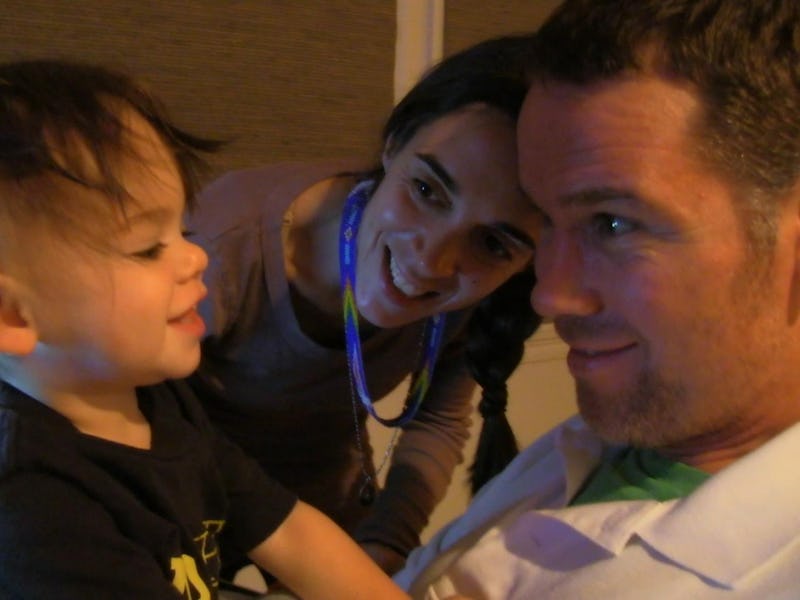Moving 'Gleason' Is The Documentary of the Summer
Hours of candid footage allow this film to be much more than a document of a terminal illness setting in.

Former New Orleans Saints defensive back Steve Gleason became a hero to both ALS patients and the wider public following his unexpected diagnosis with the disease in 2011. Gleason retired from football in 2008, and lived with his wife, Michel, in New Orleans and rural Washington. Shortly after the ALS diagnosis — believed to have been a side effect of Gleason’s often-daredevil style of playing — Michel discovered that she was pregnant. The couple decided to have the baby, even knowing that Steve’s ALS symptoms would soon become dramatic enough that he’d require 24-hour care, and that he would likely die within the next four or five years.
Gleason’s purpose in life became twofold following the ALS diagnosis. One through line was his desire to keep video journals for his future son, Rivers, and the other was to launch perhaps the most successful and ambitious ALS awareness and charity group, Team Gleason, the world had ever seen.
This year’s widely acclaimed documentary about Steve’s post-ALS diagnosis life, Gleason, is not, therefore, just a story about a man’s heroic struggle with a terminal illness, and his tireless efforts to help others struggling with the disease that was killing him. Filmed over the course of roughly five years, the deeply poignant film is about becoming a father, and about the messiness and, as Gleason himself puts it as the most advanced stages of the disease set it, “polarities” of family life.
Ultimately, Gleason — a Sundance favorite this year — succeeds most because of the things outside the American hero narrative it outlines. The film’s impact is a byproduct of the fact that Gleason and his wife Michel are hardworking, naturally resilient people.
In his public appearances — appearing in Super Bowl commercials, leading chants at the Saints stadium, interviewing Pearl Jam — and ambitious charity events — from setting up an ALS-awareness music festival, to fulfilling wishes for ALS patients out of his own pocket, to getting speech machines for ALS patients covered under Medicare and Medicaid — Gleason was undoubtedly a larger-than-life figure. Gleason carefully deconstructs a person who seems, at every turn, nearly selfless and untenably energetic given his condition. It points toward his warts and insecurities as much as it catalogues the great work he did.
The film is constructed without invasive voiceover and even secondary interviews, from both Gleason’s own documentation of his decline — heart-wrenchingly, with to-the-camera narration to his son — and documentary footage shot by a camera crew Gleason took on to document his struggle with the strange, often-misunderstood disease. Filmmaker Clay Tweel expertly weaved together a film which feels both like Gleason’s passion project (a curated diary) and an objective documentation of his chaotic, almost untenably busy life.
Steve and Michel Gleason, and more cast and crew
Out of this dichotomy evolves a deep excavation of a man who thrives on public attention and adulation, and struggles to reconcile his need to feel important and heroic with his family obligation as his disease deepens.
His feelings of self-loathing, and sense that he is becoming a burden on the people he loves most, pushes him to moments of despair which Tweel and collaborators/cameramen David Lee and Ty Minton-Small document unsparingly. Perhaps the only thing more inspiring than the notches Gleason has on his belt as an activist and philanthropist are the ways in which we see him check his natural urges at times when they might be destructive — the self-awareness and restraint he learns to exercise even at the darkest times, even when speaking his thoughts out loud takes long minutes of frustrating construction on a computer.
We see Michel fight with a speechless Gleason as she struggles to hold onto herself amid the whirlwind of events and duties she has to perform as Steve’s husband and Rivers’s mother. We see Steve seek to reconcile with his troubled family (mostly, his eccentric born-again father) before the end of his life, and document personal conversations to pass on to his son. If Rivers never gets the chance to interact with him as a young man, Steve wants him to have every resource possible to understand who his father was and what his family was like.
By exposing their flaws — by “hero” terms — it exposes, thus making Gleason and Michel something more impressive and inspiring than larger-than-life icons: people grappling with and working through crisis and tragedy the hard way. The only way to go is through, and Gleason refuses to leave out the ugly parts along the way. The footage is powerful enough — and presented naturalistically and tastefully enough — to allow viewers countless opportunities to extract their own, deeply personal conclusions from the film.